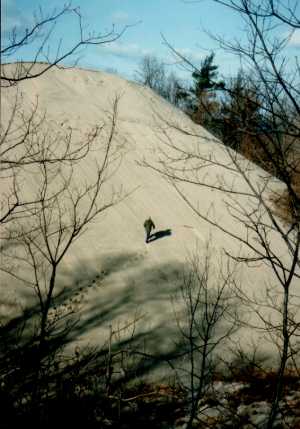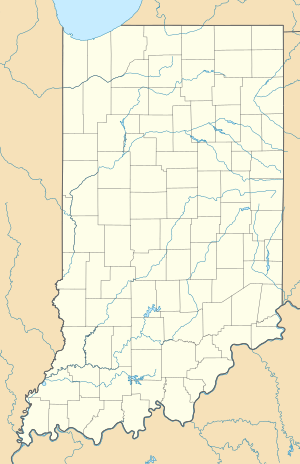Mount Baldy (sand dune) facts for kids
Quick facts for kids Mount Baldy |
|
|---|---|

View of the dune
|
|
| Coordinates | 41°42′32″N 86°55′41″W / 41.7089°N 86.9281°W |
| Range | 41°42'33"N 86°55'47"W |
| Elevation | 126 feet (38 m) |
| Age | Holocene |
Mount Baldy is a tall sand dune found in Indiana Dunes National Park. It stands 126 feet high on the southern shore of Lake Michigan. This dune is special because it is a "living dune." This means it is a wandering dune that slowly moves or shifts its shape each year.
Mount Baldy is easy to reach from U.S. Route 12, also called Dunes Highway. It sits between the town of Pines and the western edge of Michigan City, Indiana. Many people visit Mount Baldy, especially on weekends and during summer. Visitors come from nearby Chicago and other areas. Before parts of the dune were closed, people could climb 302 steps to the top. From there, they could see the skyline of Chicago. North of Mount Baldy, there is also a beach where people can swim. This beach is also part of Indiana Dunes National Park.
Contents
Why Mount Baldy Changes Shape
Mount Baldy is always changing. It is a "living dune" that moves over time. This movement is natural for sand dunes.
How People Affect the Dune
Many visitors used to walk all over Mount Baldy. This caused problems for the marram grass that grew there. This grass helps to hold the sand in place. When too much grass was destroyed, the dune started to move faster. It began advancing south, even threatening its own parking lot. To help slow this movement, the National Park Service has changed walking paths. They have also planted new grass.
Water and Sand Movement
The piers near Michigan City, Indiana also affect Mount Baldy. These structures block the natural flow of sand along the shoreline. This sand movement is called longshore drift. When the sand flow is blocked, it can make erosion worse in some areas. Erosion is when wind or water wears away the land.
Mysteries of the Moving Dune
Mount Baldy has some unique features that scientists are studying. These features are related to how the dune moves and changes.
Understanding Dune Decomposition Chimneys
In 2013, a strange hole appeared in the dune. This was a cylindrical shaft that collapsed. Scientists later studied these unusual holes. They found that these "void spaces" are caused by buried trees. Over time, these trees decay and leave hollow spaces underground. These hollow spaces are called "dune decomposition chimneys." The ground above them can be unstable.
Scientists concluded in 2016 that these chimneys are a natural part of how this "living dune" changes. Because of these hidden dangers, most of Mount Baldy is now closed to visitors. However, you can still visit the dune on special ranger-led tours. The beach near Mount Baldy reopened for swimming in the summer of 2017.


